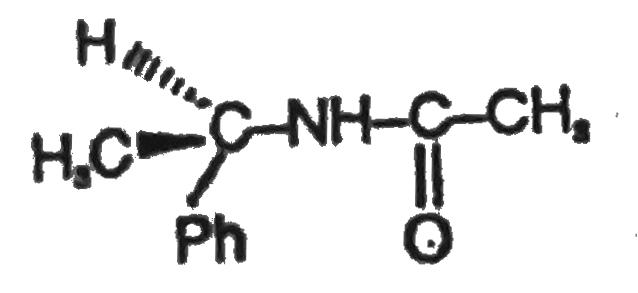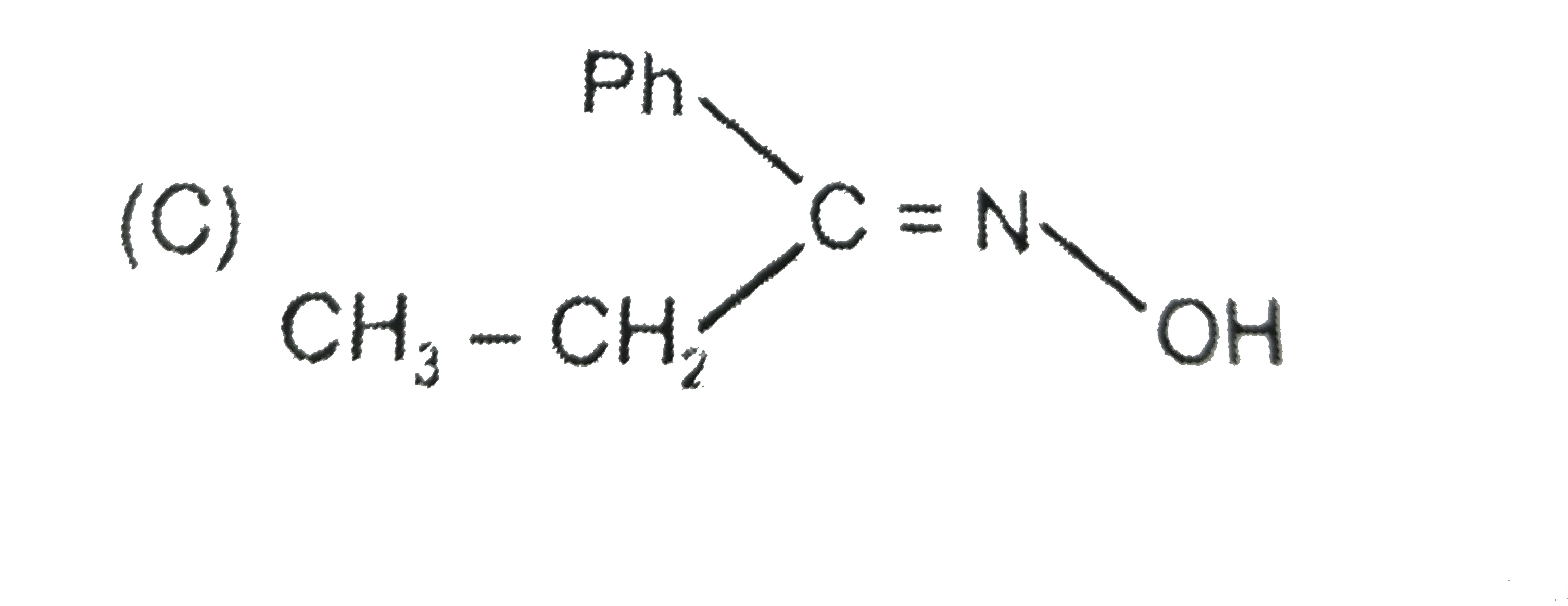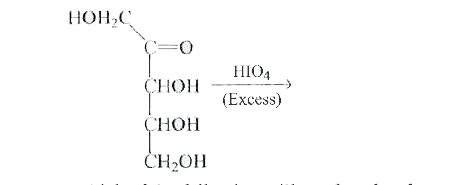Aldehydes and Ketones reacts with NH2OH to form Aldoximes and Ketoximes respectively.Configuration of these can be determined by Beckmann rearrangement as that group migrates which is anti w.r.t-OH

It is interesting to note that the migration of group is completely retentive and no loss of optical activity is seen.
 Following is true about product
Following is true about product
It is also (+) laevorotatory
Both (+) and (-) forms are obtained in equal amount
It is having 'S' configuration for chiral carbon
it is having R configuration for chiral carbon
The correct Answer is:D
Shift is retentive therefore initial configuration will be maintained. Initially It is "S" and afterwards it will be "R" due to change in Priority of atoms.

Related Playlists
Similar Practice Problems
- Question 1 - Select One
Aldehydes and Ketones reacts with NH2OH to form Aldoximes and Ketoximes respectively.Configuration of these can be determined by Beckmann rearrangement as that group migrates which is anti w.r.t-OH

It is interesting to note that the migration of group is completely retentive and no loss of optical activity is seen.
CH3CHO+NH2OHΔ−−→PH⊕−−→QBr2/KOH−−−−−−→R(CH3NH2) (as only product) Following is correctAOxime P is syn form of geometrical isomersBOxime P is anti formCQ is more basic than RDQ is H−C∣∣O−NH−CH3 - Question 1 - Select One
Alldehydes and Ketones react with NH2OH to form aldoximes and Ketoximes respectively. Configuration of these can be determined by Beckmann rearragement as that group migrates which is anti w.r.t -OH

Which step is Rate determening step ?AIBIICIIIDIV - Question 1 - Select One
Alldehydes and Ketones react with NH2OH to form aldoximes and Ketoximes respectively. Configuration of these can be determined by Beckmann rearragement as that group migrates which is anti w.r.t -OH

[X]H2SO4−−−→H2O−−→Ph−NH2+CH3−C∣∣O−OH
Identify the configuration of [X] compoundA B
B C
C D
D
- Question 1 - Select One
Monosaccharides are polyhydric aldehydes and ketones which cannot be hydrolysed into simpler carbohydrates. The monosaccharides containing −CHO group are called aldoses while those containing C=O group are called ketoses. The aldehyde group is always present at C1 while keto group is generally present at C2. All monosaccharides are oxidised by Tollen's reagent and Fehling solution and are called reducing sugars.
The monosaccharide molecules may be assigned D and L-configurations depending upon whether the configuration of the molecule is related to D- or L-glyceraldehyde. If the −OH group is attached to the carbon adjacent to the −CH2OH group (last chiral carbon) is on the right hand side, it is assigned D-configuration. The molecule is assigned L-configuration if the -OH group attached to the carbon adjacent to the −CH2OH group is on the left. The monosaccharides contain one or more chiral carbon atoms. Pentoses and hexoses have cyclic structures furanose (five membered) and pyranose (six membered). During cyclization, C1 in aldohexoses and C2 in fructose become chiral and the newly formed -OH group may be either on the left or on the right in Fischer projection formulae. These monosaccharides, therefore, exist in two stereoisomeric forms called α-anomer and β-anomer while C1andC2 are called glycosidic or anomeric carbon. The bonds joining glycosidic carbon are called glycosidic linkages. D(+) glucose exists in two stereoisomeric forms, α-D- glucose and β-D-glucose. When either of these two forms of glucose i.e., α−D−glucose are dissolved in water and allowed to stand, these get slowly converted into other form and an equilibrium mixture of both is formed. This process is called mutarotation.
The maximum number of optical isomers of glucose expected areA8B12C16D25 - Question 1 - Select One
Monosaccharides are polyhydric aldehydes and ketones which cannot be hydrolysed into simpler carbohydrates. The monosaccharides containing −CHO group are called aldoses while those containing C=O group are called ketoses. The aldehyde group is always present at C1 while keto group is generally present at C2. All monosaccharides are oxidised by Tollen's reagent and Fehling solution and are called reducing sugars.
The monosaccharide molecules may be assigned D and L-configurations depending upon whether the configuration of the molecule is related to D- or L-glyceraldehyde. If the −OH group is attached to the carbon adjacent to the −CH2OH group (last chiral carbon) is on the right hand side, it is assigned D-configuration. The molecule is assigned L-configuration if the -OH group attached to the carbon adjacent to the −CH2OH group is on the left. The monosaccharides contain one or more chiral carbon atoms. Pentoses and hexoses have cyclic structures furanose (five membered) and pyranose (six membered). During cyclization, C1 in aldohexoses and C2 in fructose become chiral and the newly formed -OH group may be either on the left or on the right in Fischer projection formulae. These monosaccharides, therefore, exist in two stereoisomeric forms called α-anomer and β-anomer while C1andC2 are called glycosidic or anomeric carbon. The bonds joining glycosidic carbon are called glycosidic linkages. D(+) glucose exists in two stereoisomeric forms, α-D- glucose and β-D-glucose. When either of these two forms of glucose i.e., α−D−glucose are dissolved in water and allowed to stand, these get slowly converted into other form and an equilibrium mixture of both is formed. This process is called mutarotation.
Which of the following pairs give positive Tollen's test?AGlucose, sucroseBGlucose, fructoseCHexanal, acetophenoneDFructose, sucrose. - Question 1 - Select One
Monosaccharides are polyhydric aldehydes and ketones which cannot be hydrolysed into simpler carbohydrates. The monosaccharides containing −CHO group are called aldoses while those containing C=O group are called ketoses. The aldehyde group is always present at C1 while keto group is generally present at C2. All monosaccharides are oxidised by Tollen's reagent and Fehling solution and are called reducing sugars.
The monosaccharide molecules may be assigned D and L-configurations depending upon whether the configuration of the molecule is related to D- or L-glyceraldehyde. If the −OH group is attached to the carbon adjacent to the −CH2OH group (last chiral carbon) is on the right hand side, it is assigned D-configuration. The molecule is assigned L-configuration if the -OH group attached to the carbon adjacent to the −CH2OH group is on the left. The monosaccharides contain one or more chiral carbon atoms. Pentoses and hexoses have cyclic structures furanose (five membered) and pyranose (six membered). During cyclization, C1 in aldohexoses and C2 in fructose become chiral and the newly formed -OH group may be either on the left or on the right in Fischer projection formulae. These monosaccharides, therefore, exist in two stereoisomeric forms called α-anomer and β-anomer while C1andC2 are called glycosidic or anomeric carbon. The bonds joining glycosidic carbon are called glycosidic linkages. D(+) glucose exists in two stereoisomeric forms, α-D- glucose and β-D-glucose. When either of these two forms of glucose i.e., α−D−glucose are dissolved in water and allowed to stand, these get slowly converted into other form and an equilibrium mixture of both is formed. This process is called mutarotation.
Which of the following statements is not correct?AMonosaccharides reduce Tollen's reagent.BOn dissolving α-D-glucose in water having specific rotation 111∘, its specific rotation decreasesCGlucose is aldohexose while fructose is ketohexoseDIn D-glucose, -OH group is present to left at 5th carbon atom. - Question 1 - Select One
1,2-diols are oxidized to ketones or aldehydes by periodic acid HIO4. Periodic acid reacts with diol to form a cyclic intermediate. The reaction takes place because iodine is in a highly positive oxidation state, so it readily accepts electrons. When the intermediate breaks down, the bond between the two carbons bonded to the OH groups break.


Which of the following will not from by above reaction?AH−O∣∣C−HBCH3OHCCO2DH−O∣∣C−OH
Similar Questions
Aldehydes and Ketones react with NH2OH to form aldoximes and Ketoximes respectively. Configuration of these can be determined by Beckmann rearragement as that group migrates which is anti w.r.t -OH

Which step is Rate determening step ?View SolutionAlldehydes and Ketones react with NH2OH to form aldoximes and Ketoximes respectively. Configuration of these can be determined by Beckmann rearragement as that group migrates which is anti w.r.t -OH

[X]H2SO4−−−→H2O−−→Ph−NH2+CH3−C∣∣O−OH
Identify the configuration of [X] compoundView SolutionAlldehydes and Ketones react with NH2OH to form aldoximes and Ketoximes respectively. Configuration of these can be determined by Beckmann rearragement as that group migrates which is anti w.r.t -OH


The product (B) is :View Solution

